Economics for Managers: A Comparative Analysis of Market Structures
VerifiedAdded on 2020/05/28
|12
|1408
|107
Report
AI Summary
This report, designed for an Economics for Managers course, provides a comparative analysis of perfect and monopolistically competitive markets. It explores the characteristics of each market structure, including the number of buyers and sellers, product differentiation, barriers to entry, and information availability. The report delves into the determination of equilibrium in both market types, examining short-run and long-run scenarios, and illustrating these concepts with figures. Furthermore, it discusses productive and allocative efficiency within the context of perfect and monopolistically competitive markets, highlighting the conditions under which these efficiencies are achieved. The report concludes with a list of relevant academic references to support its findings. This report offers a detailed explanation of the key concepts in microeconomics.
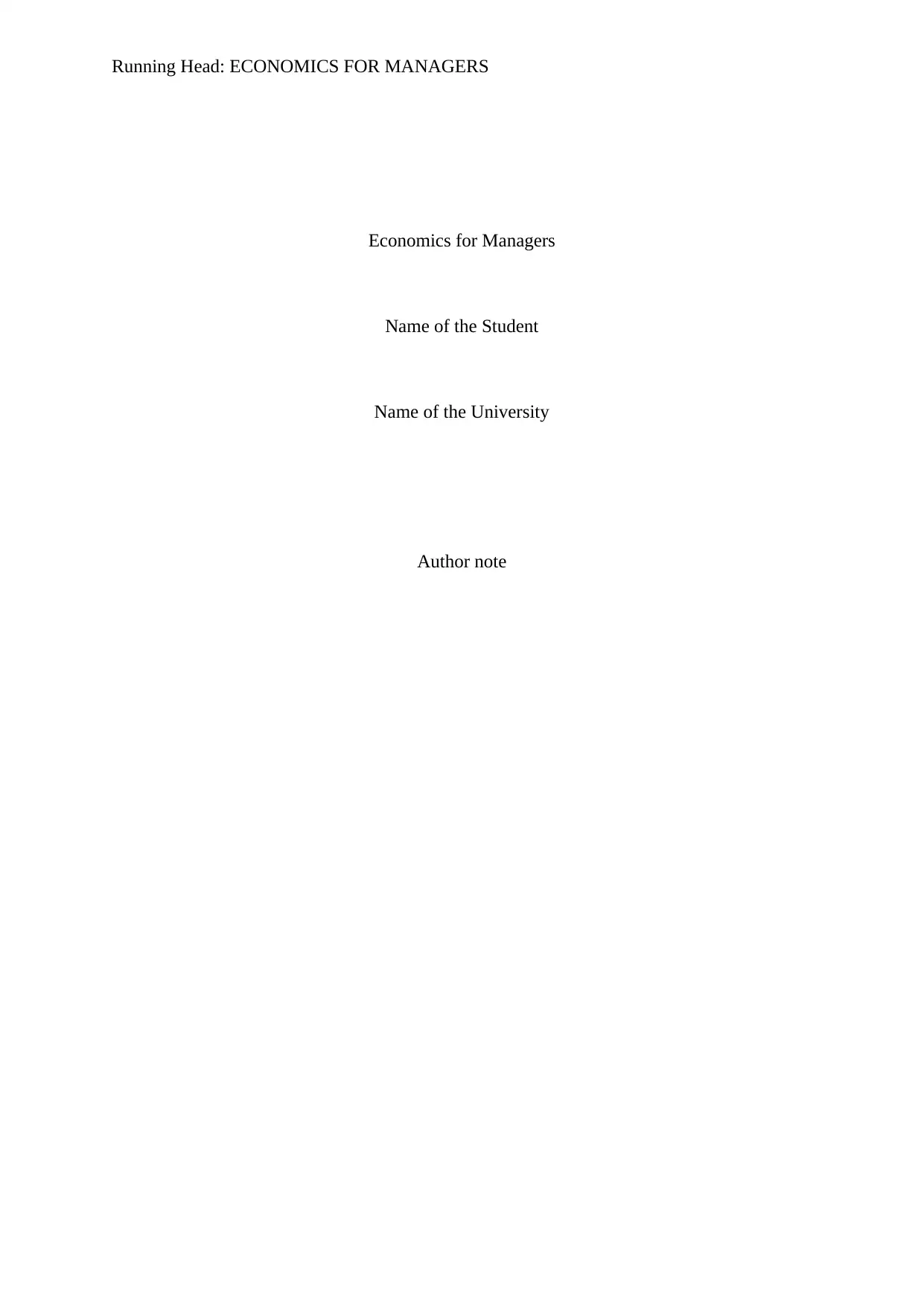
Running Head: ECONOMICS FOR MANAGERS
Economics for Managers
Name of the Student
Name of the University
Author note
Economics for Managers
Name of the Student
Name of the University
Author note
Paraphrase This Document
Need a fresh take? Get an instant paraphrase of this document with our AI Paraphraser

1
ECONOMICS FOR MANAGERS
Table of Contents
Answer a.....................................................................................................................................2
Perfect Competition...............................................................................................................2
Monopolistic competition......................................................................................................2
Equilibrium in perfectly competitive market.........................................................................3
Equilibrium in monopolistically competitive market............................................................6
Productive and allocative efficiency......................................................................................8
References................................................................................................................................11
ECONOMICS FOR MANAGERS
Table of Contents
Answer a.....................................................................................................................................2
Perfect Competition...............................................................................................................2
Monopolistic competition......................................................................................................2
Equilibrium in perfectly competitive market.........................................................................3
Equilibrium in monopolistically competitive market............................................................6
Productive and allocative efficiency......................................................................................8
References................................................................................................................................11
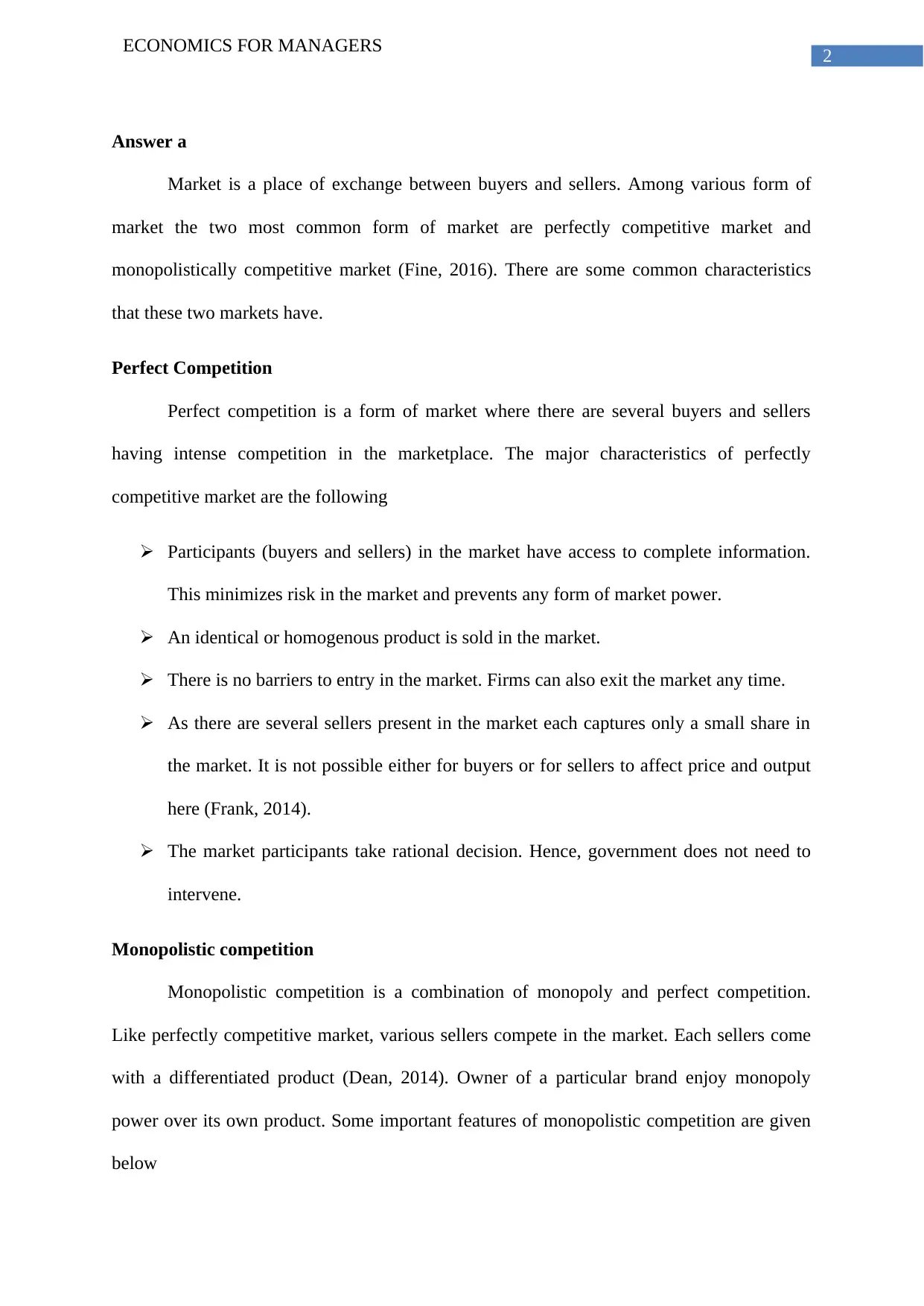
2
ECONOMICS FOR MANAGERS
Answer a
Market is a place of exchange between buyers and sellers. Among various form of
market the two most common form of market are perfectly competitive market and
monopolistically competitive market (Fine, 2016). There are some common characteristics
that these two markets have.
Perfect Competition
Perfect competition is a form of market where there are several buyers and sellers
having intense competition in the marketplace. The major characteristics of perfectly
competitive market are the following
Participants (buyers and sellers) in the market have access to complete information.
This minimizes risk in the market and prevents any form of market power.
An identical or homogenous product is sold in the market.
There is no barriers to entry in the market. Firms can also exit the market any time.
As there are several sellers present in the market each captures only a small share in
the market. It is not possible either for buyers or for sellers to affect price and output
here (Frank, 2014).
The market participants take rational decision. Hence, government does not need to
intervene.
Monopolistic competition
Monopolistic competition is a combination of monopoly and perfect competition.
Like perfectly competitive market, various sellers compete in the market. Each sellers come
with a differentiated product (Dean, 2014). Owner of a particular brand enjoy monopoly
power over its own product. Some important features of monopolistic competition are given
below
ECONOMICS FOR MANAGERS
Answer a
Market is a place of exchange between buyers and sellers. Among various form of
market the two most common form of market are perfectly competitive market and
monopolistically competitive market (Fine, 2016). There are some common characteristics
that these two markets have.
Perfect Competition
Perfect competition is a form of market where there are several buyers and sellers
having intense competition in the marketplace. The major characteristics of perfectly
competitive market are the following
Participants (buyers and sellers) in the market have access to complete information.
This minimizes risk in the market and prevents any form of market power.
An identical or homogenous product is sold in the market.
There is no barriers to entry in the market. Firms can also exit the market any time.
As there are several sellers present in the market each captures only a small share in
the market. It is not possible either for buyers or for sellers to affect price and output
here (Frank, 2014).
The market participants take rational decision. Hence, government does not need to
intervene.
Monopolistic competition
Monopolistic competition is a combination of monopoly and perfect competition.
Like perfectly competitive market, various sellers compete in the market. Each sellers come
with a differentiated product (Dean, 2014). Owner of a particular brand enjoy monopoly
power over its own product. Some important features of monopolistic competition are given
below
⊘ This is a preview!⊘
Do you want full access?
Subscribe today to unlock all pages.

Trusted by 1+ million students worldwide
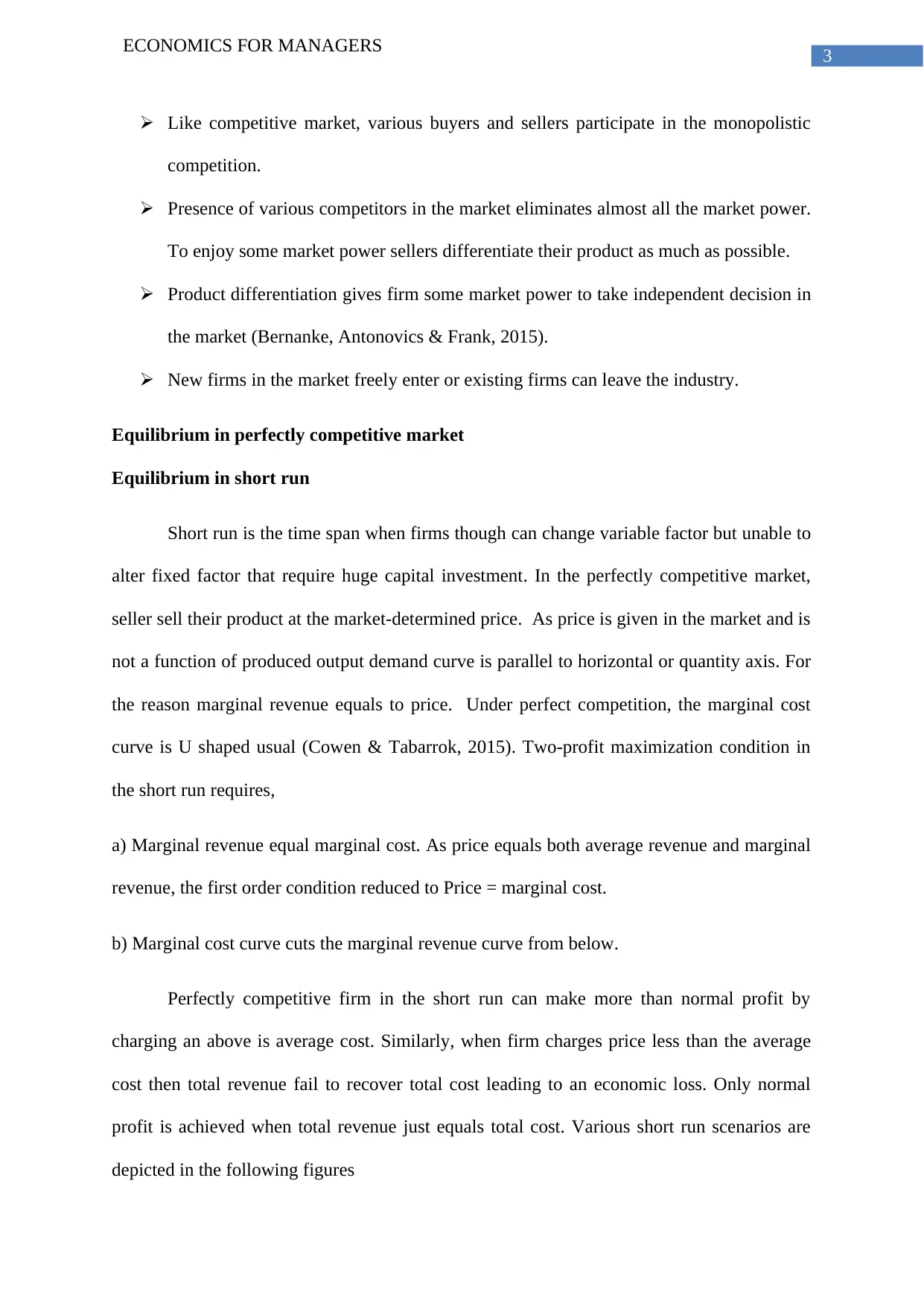
3
ECONOMICS FOR MANAGERS
Like competitive market, various buyers and sellers participate in the monopolistic
competition.
Presence of various competitors in the market eliminates almost all the market power.
To enjoy some market power sellers differentiate their product as much as possible.
Product differentiation gives firm some market power to take independent decision in
the market (Bernanke, Antonovics & Frank, 2015).
New firms in the market freely enter or existing firms can leave the industry.
Equilibrium in perfectly competitive market
Equilibrium in short run
Short run is the time span when firms though can change variable factor but unable to
alter fixed factor that require huge capital investment. In the perfectly competitive market,
seller sell their product at the market-determined price. As price is given in the market and is
not a function of produced output demand curve is parallel to horizontal or quantity axis. For
the reason marginal revenue equals to price. Under perfect competition, the marginal cost
curve is U shaped usual (Cowen & Tabarrok, 2015). Two-profit maximization condition in
the short run requires,
a) Marginal revenue equal marginal cost. As price equals both average revenue and marginal
revenue, the first order condition reduced to Price = marginal cost.
b) Marginal cost curve cuts the marginal revenue curve from below.
Perfectly competitive firm in the short run can make more than normal profit by
charging an above is average cost. Similarly, when firm charges price less than the average
cost then total revenue fail to recover total cost leading to an economic loss. Only normal
profit is achieved when total revenue just equals total cost. Various short run scenarios are
depicted in the following figures
ECONOMICS FOR MANAGERS
Like competitive market, various buyers and sellers participate in the monopolistic
competition.
Presence of various competitors in the market eliminates almost all the market power.
To enjoy some market power sellers differentiate their product as much as possible.
Product differentiation gives firm some market power to take independent decision in
the market (Bernanke, Antonovics & Frank, 2015).
New firms in the market freely enter or existing firms can leave the industry.
Equilibrium in perfectly competitive market
Equilibrium in short run
Short run is the time span when firms though can change variable factor but unable to
alter fixed factor that require huge capital investment. In the perfectly competitive market,
seller sell their product at the market-determined price. As price is given in the market and is
not a function of produced output demand curve is parallel to horizontal or quantity axis. For
the reason marginal revenue equals to price. Under perfect competition, the marginal cost
curve is U shaped usual (Cowen & Tabarrok, 2015). Two-profit maximization condition in
the short run requires,
a) Marginal revenue equal marginal cost. As price equals both average revenue and marginal
revenue, the first order condition reduced to Price = marginal cost.
b) Marginal cost curve cuts the marginal revenue curve from below.
Perfectly competitive firm in the short run can make more than normal profit by
charging an above is average cost. Similarly, when firm charges price less than the average
cost then total revenue fail to recover total cost leading to an economic loss. Only normal
profit is achieved when total revenue just equals total cost. Various short run scenarios are
depicted in the following figures
Paraphrase This Document
Need a fresh take? Get an instant paraphrase of this document with our AI Paraphraser
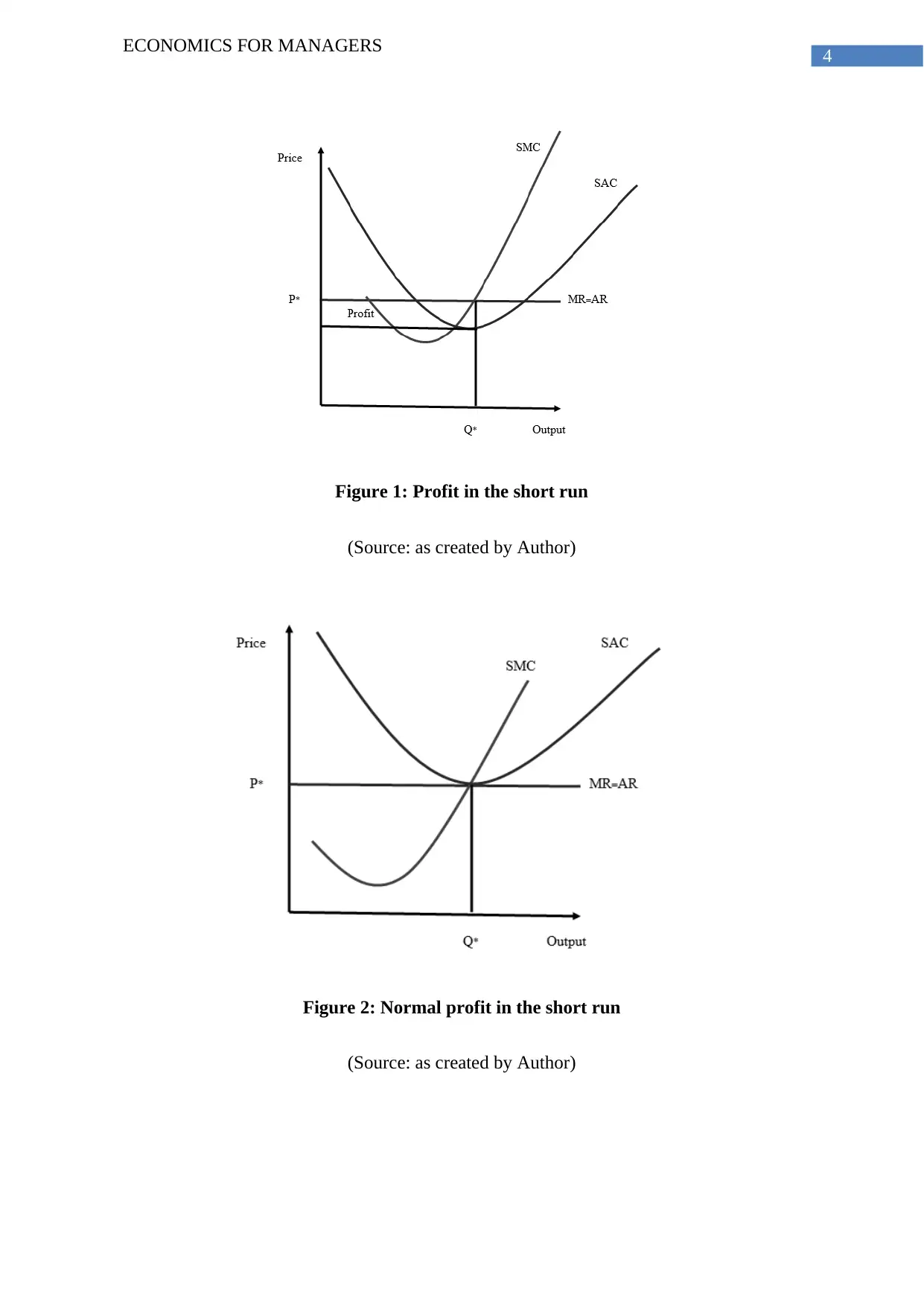
4
ECONOMICS FOR MANAGERS
Figure 1: Profit in the short run
(Source: as created by Author)
Figure 2: Normal profit in the short run
(Source: as created by Author)
ECONOMICS FOR MANAGERS
Figure 1: Profit in the short run
(Source: as created by Author)
Figure 2: Normal profit in the short run
(Source: as created by Author)

5
ECONOMICS FOR MANAGERS
Figure 3: Loss in the short run
(Source: as created by Author)
Equilibrium in the long-run
The long run situation is different from the short run. In the long run firms are able to
make changes their variable factors. In the long-run new firms can enter the market if the
industry is profitable and existing firms enjoy above normal profit. Firms leave the industry if
they continuously suffer a loss. Both the extreme situations reduced to a situation where firms
in the industry earns only a normal profit. When firms make profit, this encourages new firms
to join the industry. The increased number of firms in the industry increases industry supply
and reduce price to the level where it equals to minimum average cost (Arrow, 2015). In this
situation, firms earn only a normal profit.
ECONOMICS FOR MANAGERS
Figure 3: Loss in the short run
(Source: as created by Author)
Equilibrium in the long-run
The long run situation is different from the short run. In the long run firms are able to
make changes their variable factors. In the long-run new firms can enter the market if the
industry is profitable and existing firms enjoy above normal profit. Firms leave the industry if
they continuously suffer a loss. Both the extreme situations reduced to a situation where firms
in the industry earns only a normal profit. When firms make profit, this encourages new firms
to join the industry. The increased number of firms in the industry increases industry supply
and reduce price to the level where it equals to minimum average cost (Arrow, 2015). In this
situation, firms earn only a normal profit.
⊘ This is a preview!⊘
Do you want full access?
Subscribe today to unlock all pages.

Trusted by 1+ million students worldwide
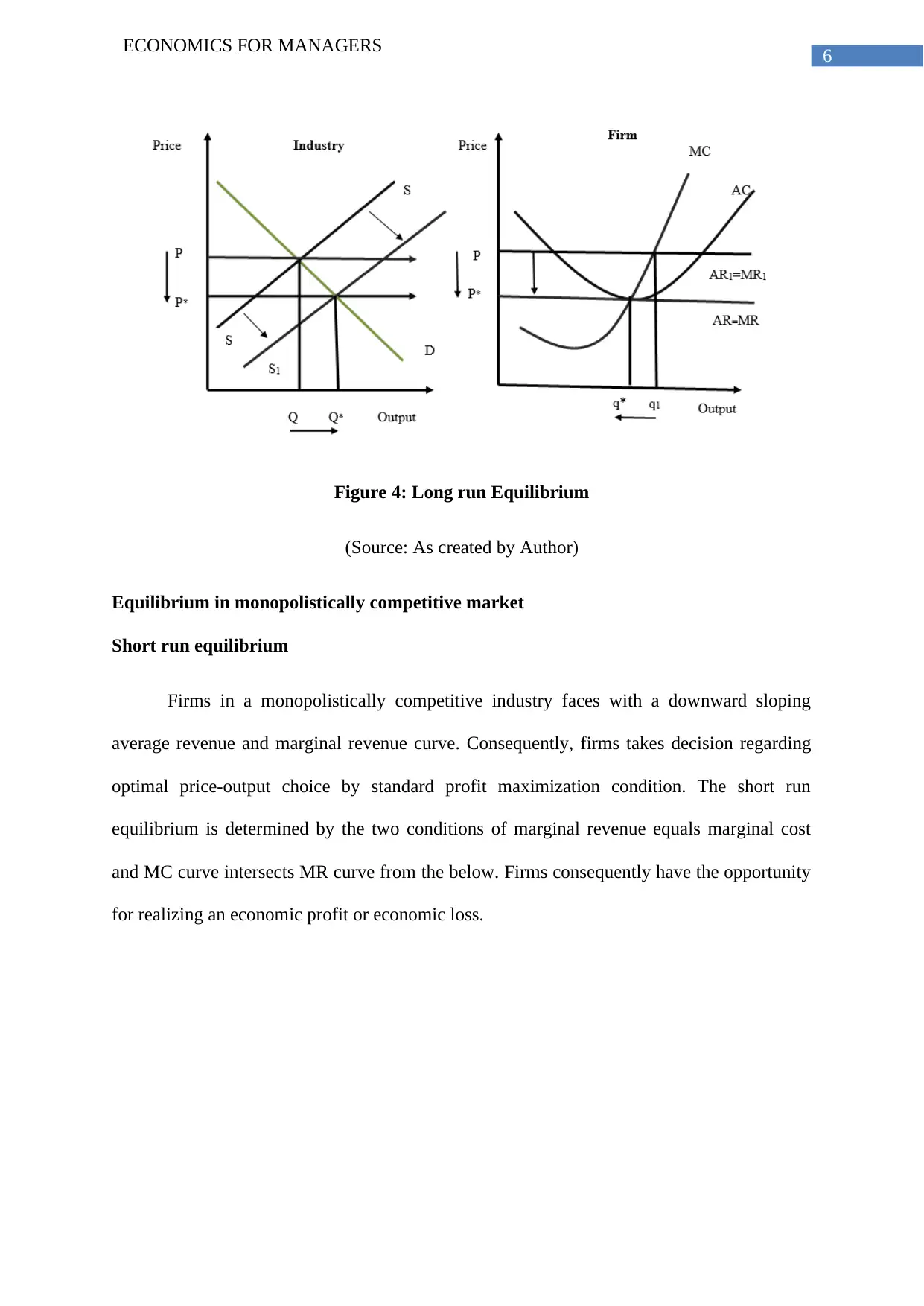
6
ECONOMICS FOR MANAGERS
Figure 4: Long run Equilibrium
(Source: As created by Author)
Equilibrium in monopolistically competitive market
Short run equilibrium
Firms in a monopolistically competitive industry faces with a downward sloping
average revenue and marginal revenue curve. Consequently, firms takes decision regarding
optimal price-output choice by standard profit maximization condition. The short run
equilibrium is determined by the two conditions of marginal revenue equals marginal cost
and MC curve intersects MR curve from the below. Firms consequently have the opportunity
for realizing an economic profit or economic loss.
ECONOMICS FOR MANAGERS
Figure 4: Long run Equilibrium
(Source: As created by Author)
Equilibrium in monopolistically competitive market
Short run equilibrium
Firms in a monopolistically competitive industry faces with a downward sloping
average revenue and marginal revenue curve. Consequently, firms takes decision regarding
optimal price-output choice by standard profit maximization condition. The short run
equilibrium is determined by the two conditions of marginal revenue equals marginal cost
and MC curve intersects MR curve from the below. Firms consequently have the opportunity
for realizing an economic profit or economic loss.
Paraphrase This Document
Need a fresh take? Get an instant paraphrase of this document with our AI Paraphraser
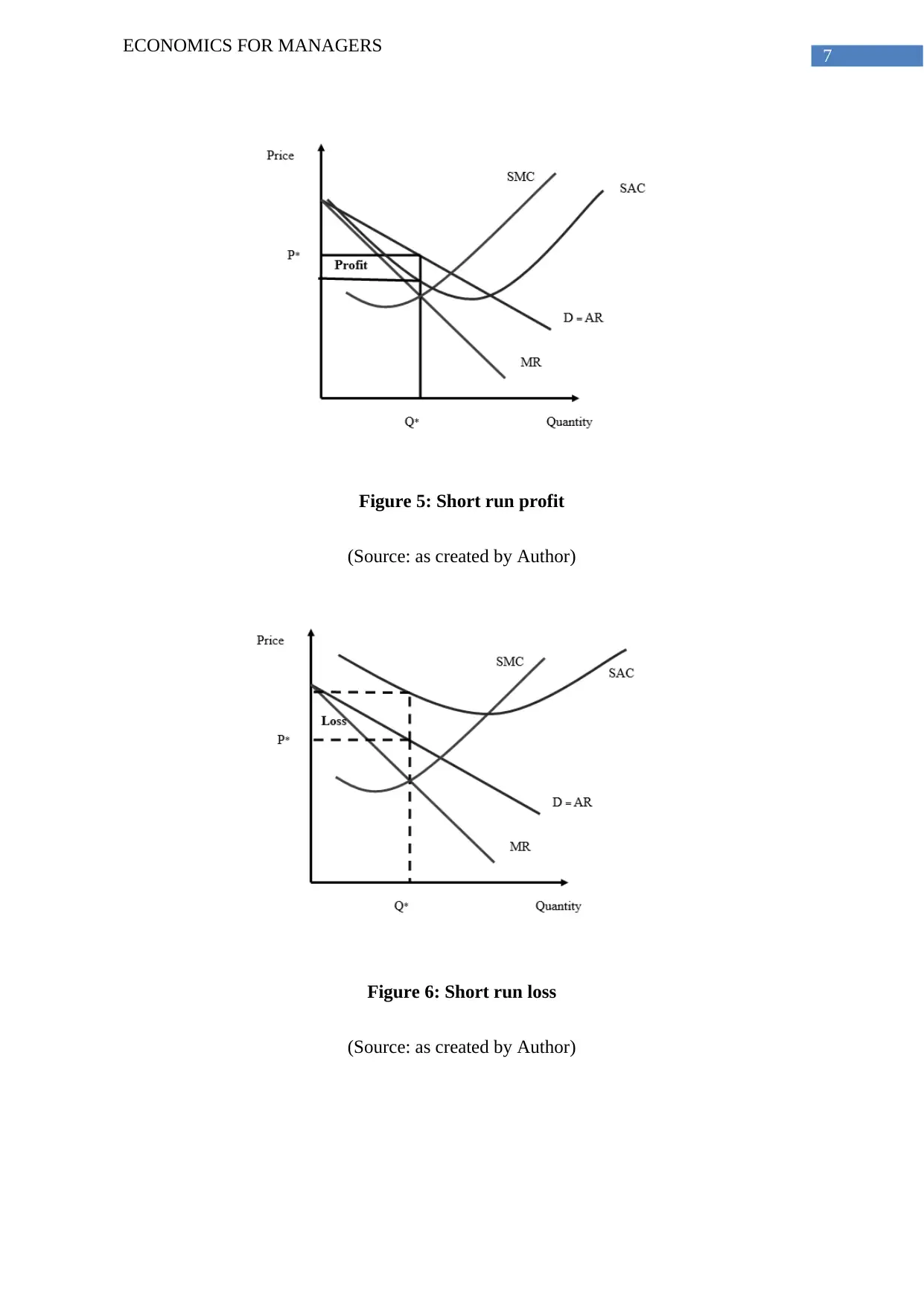
7
ECONOMICS FOR MANAGERS
Figure 5: Short run profit
(Source: as created by Author)
Figure 6: Short run loss
(Source: as created by Author)
ECONOMICS FOR MANAGERS
Figure 5: Short run profit
(Source: as created by Author)
Figure 6: Short run loss
(Source: as created by Author)

8
ECONOMICS FOR MANAGERS
Long run equilibrium
Firms under monopolistic competition earn just a normal profit in the long-run. Any
abnormal profit or loss in the short run eliminated by free entry or exit of firms leading to
only a normal profit. However, it may seem similar to that of long run situation under perfect
competition but the price output combination is different from perfect competition. Here, firm
produces a quantity less than the perfectly competitive industry (Hubbard et al., 2015). The
difference between the socially optimum quantity and long run equilibrium quantity in the
industry is called excess capacity.
Figure 7: Long run equilibrium and excess capacity
(Source: as created by Author)
Productive and allocative efficiency
Productive efficiency symbolizes a situation in which production is conducted with
optimal use of all the resources. Any production combination on production possibility curve
is productively efficient (Blad & Keiding, 2014). Allocative efficiency is related to the
socially optimal production choice.
ECONOMICS FOR MANAGERS
Long run equilibrium
Firms under monopolistic competition earn just a normal profit in the long-run. Any
abnormal profit or loss in the short run eliminated by free entry or exit of firms leading to
only a normal profit. However, it may seem similar to that of long run situation under perfect
competition but the price output combination is different from perfect competition. Here, firm
produces a quantity less than the perfectly competitive industry (Hubbard et al., 2015). The
difference between the socially optimum quantity and long run equilibrium quantity in the
industry is called excess capacity.
Figure 7: Long run equilibrium and excess capacity
(Source: as created by Author)
Productive and allocative efficiency
Productive efficiency symbolizes a situation in which production is conducted with
optimal use of all the resources. Any production combination on production possibility curve
is productively efficient (Blad & Keiding, 2014). Allocative efficiency is related to the
socially optimal production choice.
⊘ This is a preview!⊘
Do you want full access?
Subscribe today to unlock all pages.

Trusted by 1+ million students worldwide

9
ECONOMICS FOR MANAGERS
Figure 8: Productive efficiency
(Source: as created by Author)
Figure 9: Allocative efficiency
(Source: as created by Author)
ECONOMICS FOR MANAGERS
Figure 8: Productive efficiency
(Source: as created by Author)
Figure 9: Allocative efficiency
(Source: as created by Author)
Paraphrase This Document
Need a fresh take? Get an instant paraphrase of this document with our AI Paraphraser
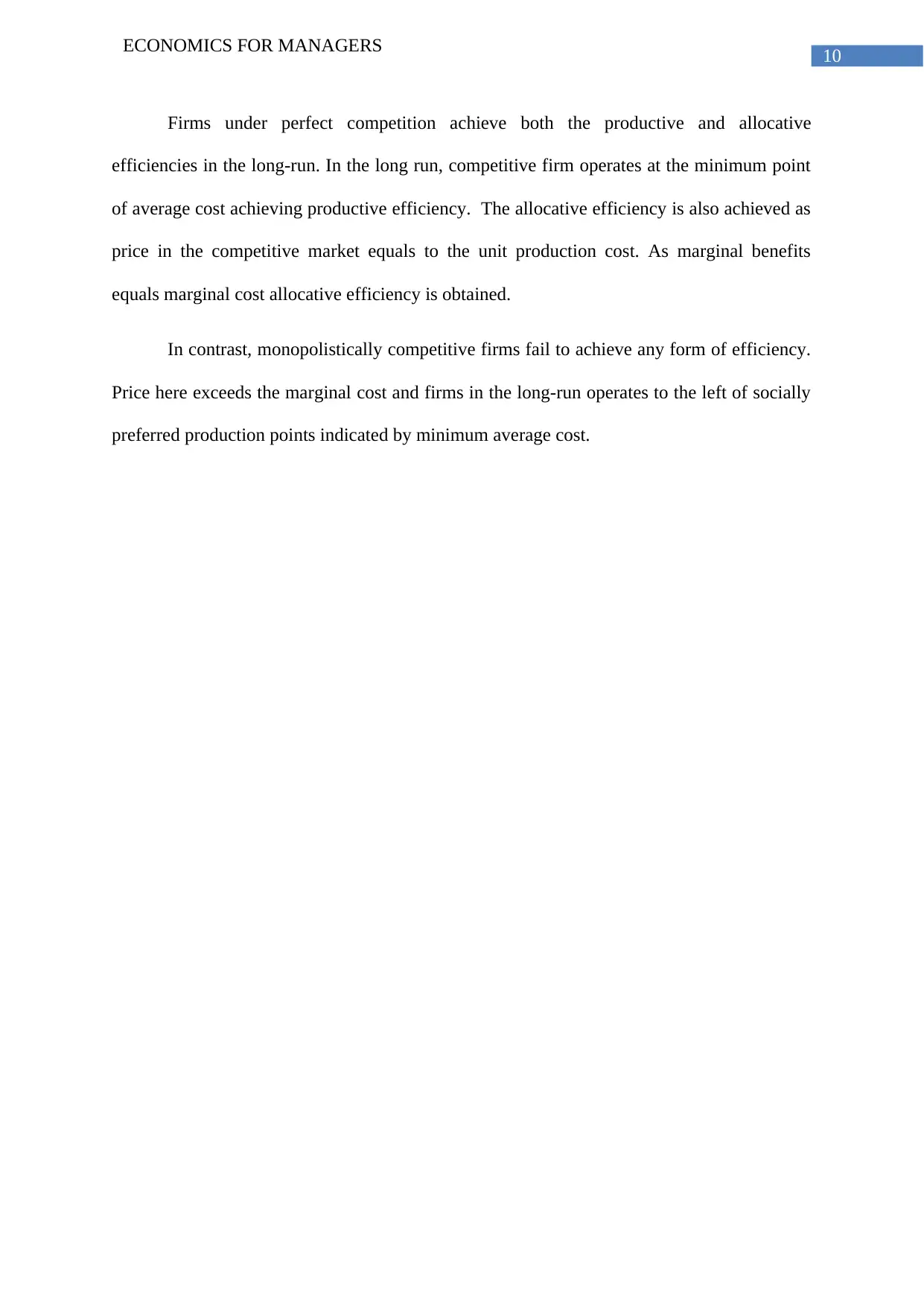
10
ECONOMICS FOR MANAGERS
Firms under perfect competition achieve both the productive and allocative
efficiencies in the long-run. In the long run, competitive firm operates at the minimum point
of average cost achieving productive efficiency. The allocative efficiency is also achieved as
price in the competitive market equals to the unit production cost. As marginal benefits
equals marginal cost allocative efficiency is obtained.
In contrast, monopolistically competitive firms fail to achieve any form of efficiency.
Price here exceeds the marginal cost and firms in the long-run operates to the left of socially
preferred production points indicated by minimum average cost.
ECONOMICS FOR MANAGERS
Firms under perfect competition achieve both the productive and allocative
efficiencies in the long-run. In the long run, competitive firm operates at the minimum point
of average cost achieving productive efficiency. The allocative efficiency is also achieved as
price in the competitive market equals to the unit production cost. As marginal benefits
equals marginal cost allocative efficiency is obtained.
In contrast, monopolistically competitive firms fail to achieve any form of efficiency.
Price here exceeds the marginal cost and firms in the long-run operates to the left of socially
preferred production points indicated by minimum average cost.
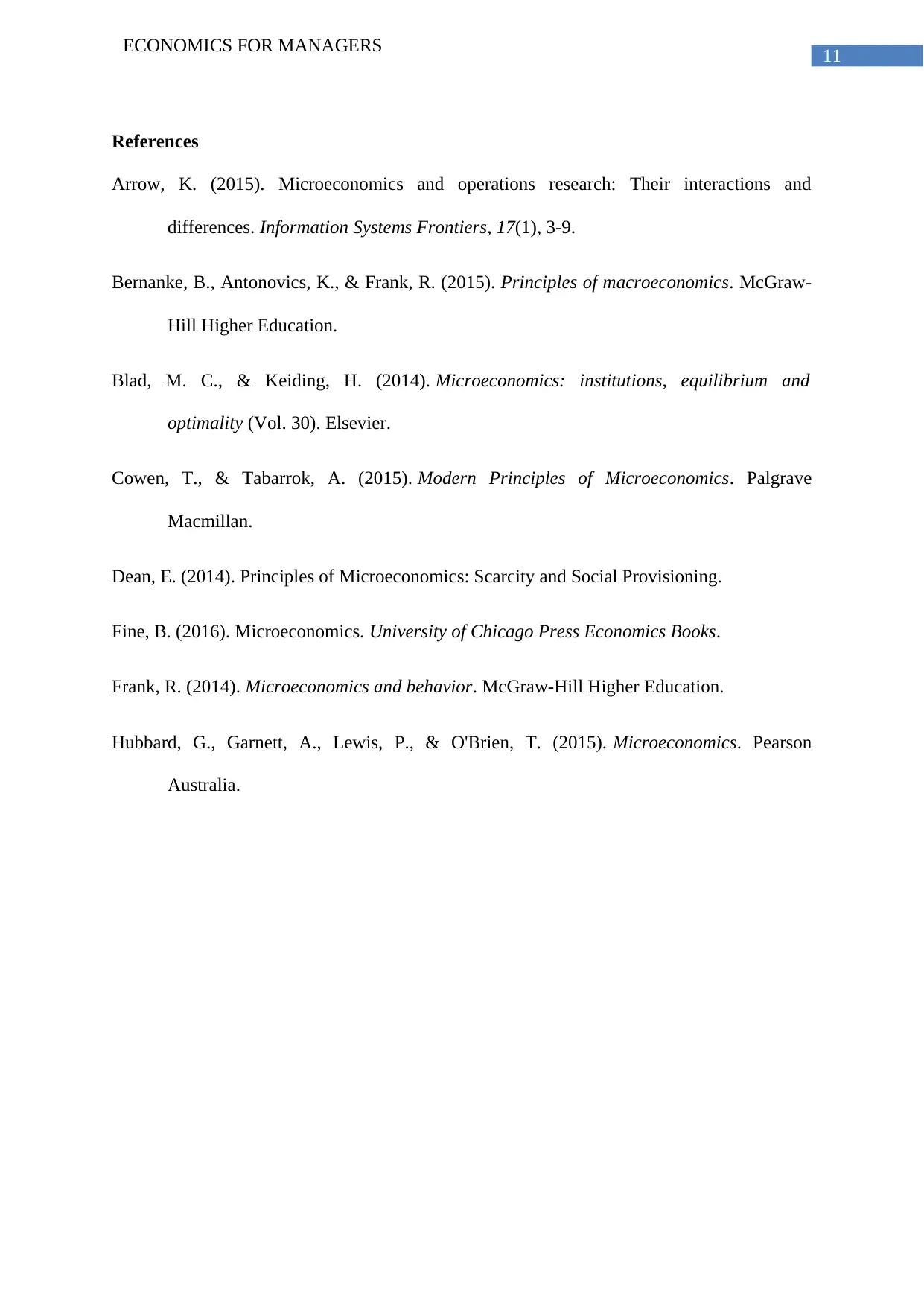
11
ECONOMICS FOR MANAGERS
References
Arrow, K. (2015). Microeconomics and operations research: Their interactions and
differences. Information Systems Frontiers, 17(1), 3-9.
Bernanke, B., Antonovics, K., & Frank, R. (2015). Principles of macroeconomics. McGraw-
Hill Higher Education.
Blad, M. C., & Keiding, H. (2014). Microeconomics: institutions, equilibrium and
optimality (Vol. 30). Elsevier.
Cowen, T., & Tabarrok, A. (2015). Modern Principles of Microeconomics. Palgrave
Macmillan.
Dean, E. (2014). Principles of Microeconomics: Scarcity and Social Provisioning.
Fine, B. (2016). Microeconomics. University of Chicago Press Economics Books.
Frank, R. (2014). Microeconomics and behavior. McGraw-Hill Higher Education.
Hubbard, G., Garnett, A., Lewis, P., & O'Brien, T. (2015). Microeconomics. Pearson
Australia.
ECONOMICS FOR MANAGERS
References
Arrow, K. (2015). Microeconomics and operations research: Their interactions and
differences. Information Systems Frontiers, 17(1), 3-9.
Bernanke, B., Antonovics, K., & Frank, R. (2015). Principles of macroeconomics. McGraw-
Hill Higher Education.
Blad, M. C., & Keiding, H. (2014). Microeconomics: institutions, equilibrium and
optimality (Vol. 30). Elsevier.
Cowen, T., & Tabarrok, A. (2015). Modern Principles of Microeconomics. Palgrave
Macmillan.
Dean, E. (2014). Principles of Microeconomics: Scarcity and Social Provisioning.
Fine, B. (2016). Microeconomics. University of Chicago Press Economics Books.
Frank, R. (2014). Microeconomics and behavior. McGraw-Hill Higher Education.
Hubbard, G., Garnett, A., Lewis, P., & O'Brien, T. (2015). Microeconomics. Pearson
Australia.
⊘ This is a preview!⊘
Do you want full access?
Subscribe today to unlock all pages.

Trusted by 1+ million students worldwide
1 out of 12
Related Documents
Your All-in-One AI-Powered Toolkit for Academic Success.
+13062052269
info@desklib.com
Available 24*7 on WhatsApp / Email
![[object Object]](/_next/static/media/star-bottom.7253800d.svg)
Unlock your academic potential
Copyright © 2020–2025 A2Z Services. All Rights Reserved. Developed and managed by ZUCOL.





